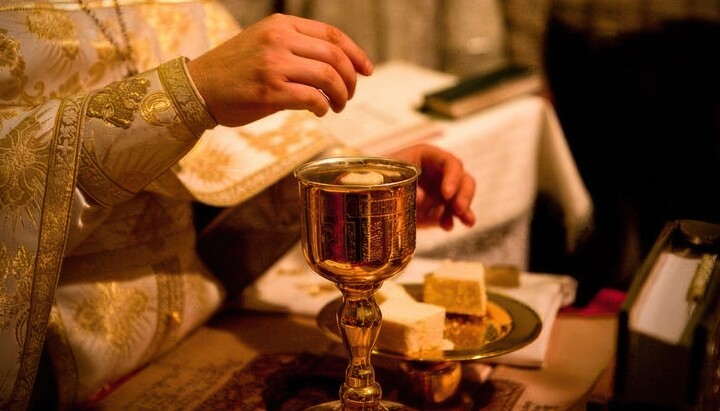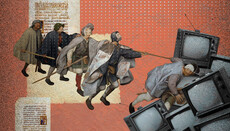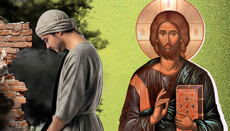What happens to the bread and wine during the Liturgy?

For the Church, the Divine Liturgy is not a theatrical performance, but a sacred act in which the Holy Spirit truly transforms the bread and wine into the Body and Blood of the Savior.
Christ is the backbone of the life of the Orthodox Church – Christ who offers us His Body and Blood in the sacrament of the Divine Eucharist. It is crucial to understand that the Liturgy is not merely a ritual, a commemorative service, or a symbolic union with Christ, but a real, mysterious (inexplicable from a rational or human standpoint), and effective participation in the true Body and Blood of Christ. The question of what exactly happens to the bread and wine during the Liturgy is not an abstract theological issue detached from real life, but a question that touches the very heart of our faith.
Unfortunately, today one increasingly hears the claim that nothing actually happens to the bread and wine in an ontological sense during the Liturgy – that they allegedly remain bread and wine and become the Body and Blood of Christ only in the personal, subjective experience of the communicant. One of the most well-known proponents of this view is Moscow Theological Academy professor Alexei Osipov.
Let us examine his arguments – and respond to them with reference to the Sacred Tradition of the Church, the words of the holy fathers, and the liturgical experience of Orthodoxy.
Osipov’s position
In various lectures (for example, “The Mystery of the Eucharist”), Osipov asserts the following:
There is no “transubstantiation” at the Liturgy in the Western sense of the word, since, in his opinion, this contradicts the concept of a Mystery as something "mystical," that is, incomprehensible.
According to Osipov (and those who follow him), the bread and wine remain physically unchanged but become “the Body and Blood” of Christ only in the context of the believer’s spiritual experience.
He argues that it is absurd to speak of the real transformation of bread and wine into Christ’s Body and Blood from scientific, biological, and philosophical perspectives. He also considers the concept to be a product of Western scholasticism.
Osipov often cites Saints Gregory the Theologian and John Chrysostom, claiming that “none of the Fathers spoke of transubstantiation in an ontological sense.”
But is this really true?
The Teaching of the Church and the Fathers
From its earliest days, the Orthodox Church has not only believed in the real presence of Christ in the Eucharist but has taught the actual, true, mysterious – yet real – transformation of the bread and wine into the Body and Blood of Christ.
For instance, St. Justin Martyr writes: “We do not receive these things as common bread and drink; but as Jesus Christ our Savior, having been made flesh by the Word of God, had both flesh and blood for our salvation, so likewise have we been taught that the food blessed by the prayer of His word and from which our blood and flesh are nourished, is the flesh and blood of that incarnate Jesus.”
St. Cyril of Jerusalem says: “Before the holy invocation of the Trinity, the bread and wine are simply bread and wine. But after the invocation, the bread becomes the Body of Christ and the wine the Blood of Christ.”
St. Theophylact of Bulgaria similarly affirms: “Remember that the bread which we break in the Mystery is not an image of the Lord’s Body, but is the very Body of the Lord... Through the mystical blessing and the descent of the Holy Spirit, the bread is changed into the Flesh of the Lord… It is not an image, but is truly transformed into the Body of Christ.”
Some opponents of this teaching claim that in the Liturgy of St. Basil the Great the Gifts are called “antitypes,” and therefore the presence of Christ in them must be symbolic. However, St. John of Damascus long ago addressed this objection:
“The bread and the wine are not images of the Body and Blood of Christ – far from it – but the deified Body of the Lord itself. For the Lord Himself said: ‘This is My Body’ (Matt. 26:26), not ‘an image of My Body.’ And ‘This is My Blood’ (Matt. 26:28), not ‘an image of My Blood’… If some have referred to the bread and wine as ‘antitypes’ of the Body and Blood, such as St. Basil, they were referring to the Gifts before consecration, not after.”
St. John Chrysostom is even more direct: “Many now say, ‘I wish I could see His face, His garments, His sandals.’ You do see Him, you touch Him, you eat Him. He gives you not only to see Him but even to touch Him and to eat Him and receive Him within.”
Thus, nearly all the Fathers of the Church speak clearly and explicitly of the change, transformation, and transmutation of the bread and wine – not in a metaphorical or symbolic sense, but in a real, ontological sense.
Liturgical testimony
In all Eastern Liturgies, we find the epiclesis, the prayer in which the priest calls upon the Holy Spirit, saying: “Make this bread the precious Body of our Lord and God and Savior Jesus Christ. And what is in this cup, the precious Blood of our Lord and God and Savior Jesus Christ…”
The Church prays for this – not for a symbol or psychological effect, but for the real Body and Blood of Christ.
Afer all, the Liturgy is not a performance or meditative reenactment of the Last Supper, but a sacred act in which the Holy Spirit performs the real transformation of bread and wine into the Body and Blood of the Savior.
On “Western scholastic influence”
Yes, in the Roman Catholic Church, the term transsubstantiatio (transubstantiation) was formally introduced in the 13th century, based on Aristotelian categories of “substance” and “accidents.” However, as we’ve seen, the Orthodox Church’s belief in the real change of the Gifts predates this terminology and is not based on philosophy but on the liturgical and patristic understanding of the Eucharist.
Saint Mark of Ephesus – whose views were certainly not influenced by Catholic theology, as he spent nearly his entire life opposing it – writes that during the Great Entrance, “the sacred Bread, not yet sanctified and as if lifeless, shortly thereafter, by the action of the Life-Giving Spirit, becomes living and is transubstantiated into the very Life-Giving Body.”
As we can see, he uses the term transubstantiation without hesitation, not in opposition to it – much less to the patristic understanding of the mystical transformation of bread and wine – but rather to the attempts to comprehend this mystery through human reason or philosophy.
In essence, Saint Mark believes that the bread and wine are offered, changed, transformed, and transubstantiated into the Body and Blood of Christ, while rejecting attempts to define how this occurs (as in the Catholic teaching of substance and accidents).
For Saint Mark, as for other holy fathers, the important thing is not a rational explanation of the Mystery, but faith in the reality of what takes place. This is the Orthodox approach: we believe that in the Liturgy, the bread and wine truly become the Body and Blood of the Savior – and we do not require a philosophical framework to explain how.
The error of “psychological symbolism”
The idea that the transformation happens only “for the believer,” in their mind or perception, undermines the very foundation of the Liturgy. If the Gifts are mere symbols activated by faith, then the Sacrament depends on subjective feelings, not the action of the Holy Spirit. Moreover, the Apostle Paul’s warning in 1 Corinthians 11:27–30 becomes meaningless:
“Whoever eats the bread or drinks the cup of the Lord in an unworthy manner will be guilty of the Body and Blood of the Lord… For anyone who eats and drinks without discerning the Body eats and drinks judgment on himself.”
If it were just bread and wine – why the judgment?
Conclusion
The Orthodox Church has never feared the word 'transubstantiation', though it does not insist on its philosophical framework. What the Church has always affirmed is the essential truth of our faith: during the Divine Liturgy, the bread and wine truly become the Body and Blood of Christ.
This faith is not rooted in philosophical systems or theological speculation, but in the heart of the Church’s life, preserved in the teachings of the Apostles and the Holy Fathers. And if Christ says, “Take, eat: this is My Body…” (Matt. 26:26), and we try to argue otherwise – then either we are not truly Christians, or we do not understand what the Liturgy truly is.











